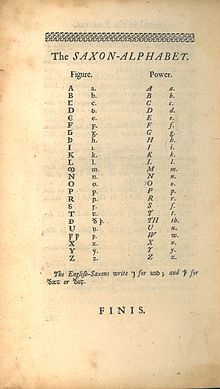Alfabet Latin Inggris Kuno

Alfabet Latin Inggris Kuno (bahasa Inggris Kuno: Læden stæfrof) secara umum terdiri atas 24 huruf yang digunakan untuk menulis bahasa Inggris Kuno dari abad ke-8 hingga ke-12. Sebanyak 20 huruf diturunkan langsung dari alfabet Latin, dua huruf Latin yang termodifikasi (Æ, Ð), dan dua dikembangkan dari alfabet Rune (Ƿ, Þ). Huruf K, Q, dan Z tidak digunakan untuk menulis kata-kata bahasa Inggris asli.
Huruf
[sunting | sunting sumber]| Huruf besar | |||||||||||||||||||||||||||||||||||
|---|---|---|---|---|---|---|---|---|---|---|---|---|---|---|---|---|---|---|---|---|---|---|---|---|---|---|---|---|---|---|---|---|---|---|---|
| A | Æ | B | C | D | Ð | E | F | Ᵹ/G | H | I | L | M | N | O | P | R | S | T | Þ | U | Ƿ | X | Y | ||||||||||||
| Huruf kecil | |||||||||||||||||||||||||||||||||||
| a | æ | b | c | d | ð | e | f | ᵹ/g | h | i | l | m | n | o | p | r | s/ſ | t | þ | u | ƿ | x | y | ||||||||||||
Bahasa Inggris Kuno ditulis dalam Alfabet Rune (Futhorc) namun beralih menggunakan huruf paruh uncial dari Alfabet Latin yang diperkenalkan oleh misionaris Katolik Irlandia[2] pada abad ke-8. Huruf-huruf tersebut diganti oleh insular, suatu ragam kursif dan runcing dari huruf paruh uncial. Ragam huruf-huruf tersebut digunakan hingga akhir abad ke-12 ketika minuskul Karoling menggantikan insular, bersama dengan pergeseran konvensi ejaan ke arah Alfabet Prancis Kuno, mulai umum digunakan ketika memasuki era bahasa Inggris Pertengahan.
Huruf ðæt ⟨ð⟩ (disebut eth atau edh dalam bahasa Inggris Modern) adalah modifikasi dari huruf ⟨d⟩, sedangkan huruf thorn ⟨þ⟩ dan wynn ⟨ƿ⟩ diserap dari Futhorc. Juga digunakan simbol untuk kata hubung dan, sebuah karakter yang mirip angka tujuh (⟨⁊⟩, disebut tanda Tironia atau ond), dan simbol untuk kata ganti relatif þæt (berarti "itu"), sebuah thorn dengan palang melintang (⟨ꝥ⟩). Makron ⟨¯⟩ di atas vokal jarang digunakan untuk menunjukkan vokal yang panjang, tetapi juga kadang-kadang digunakan sebagai indikator sengau (semacam tilde) jika vokal digantikan oleh s (ms atau ns akan berubah menjadi ◌̄s).
Referensi
[sunting | sunting sumber]Catatan kaki
[sunting | sunting sumber]- ^ John Fortescue (1714), The Difference between an Absolute and Limited Monarchy: As it More Particularly Regards the English Constitution. Being a Treatise Written by Sir John Fortescue, Kt. Lord Chief Justice, and Lord High Chancellor of England, under King Henry VI. Faithfully Transcribed from the MS. Copy in the Bodleian Library, and Collated with Three Other MSS. Publish'd with some Remarks by John Fortescue-Aland, of the Inner-Temple, Esq; F.R.S. (edisi ke-1st), London: John Fortescue Aland; printed by W[illiam] Bowyer in White-Fryars, for E. Parker at the Bible and Crown in Lombard-Street, and T. Ward in the Inner-Temple-Lane, OCLC 642421515.
- ^ Crystal, David (1987). The Cambridge Encyclopedia of Language
 . Cambridge University Press. hlm. 203. ISBN 0-521-26438-3.
. Cambridge University Press. hlm. 203. ISBN 0-521-26438-3.
Daftar pustaka
[sunting | sunting sumber]- J. Bosworth & T. Northcote Toller, An Anglo-Saxon Dictionary, Clarendon Press, Oxford, 1898
Pranala luar
[sunting | sunting sumber]- "Old English / Anglo-Saxon (Englisc)". Omniglot. omniglot.com. Diarsipkan dari versi asli tanggal 7 April 2010. Diakses tanggal 17 July 2010.
Text is available under the CC BY-SA 4.0 license; additional terms may apply.
Images, videos and audio are available under their respective licenses.
